Near transfer to an unrelated N-back task mediates the effect of N-back working memory training on matrix reasoning
- PMID: 35726054
- PMCID: PMC12305750
- DOI: 10.1038/s41562-022-01384-w
Near transfer to an unrelated N-back task mediates the effect of N-back working memory training on matrix reasoning
Erratum in
-
Author Correction: Near transfer to an unrelated N-back task mediates the effect of N-back working memory training on matrix reasoning.Nat Hum Behav. 2023 Feb;7(2):292. doi: 10.1038/s41562-022-01514-4. Nat Hum Behav. 2023. PMID: 36720937 No abstract available.
Abstract
The extent to which working memory training improves performance on untrained tasks is highly controversial. Here we address this controversy by testing the hypothesis that far transfer may depend on near transfer using mediation models in three separate randomized controlled trials (RCTs). In all three RCTs, totalling 460 individuals, performance on untrained N-back tasks (near transfer) mediated transfer to Matrix Reasoning (representing far transfer) despite the lack of an intervention effect in RCTs 2 and 3. Untrained N-back performance also mediated transfer to a working memory composite, which showed a significant intervention effect (RCT 3). These findings support a model of N-back training in which transfer to untrained N-back tasks gates further transfer (at least in the case of working memory at the construct level) and Matrix Reasoning. This model can help adjudicate between the many studies and meta-analyses of working memory training that have provided mixed results but have not examined the relationship between near and far transfer on an individual-differences level.
© 2022. The Author(s), under exclusive licence to Springer Nature Limited.
Conflict of interest statement
Competing Interests
S.M.J. has an indirect financial conflict of interest with the MIND Research Institute, whose interests are related to this work. The remaining authors declare no competing interests.
Figures
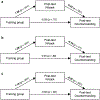





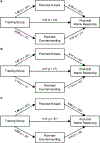

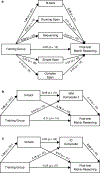
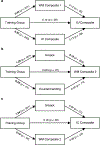
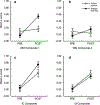
Similar articles
-
Short-Term Memory Impairment.2024 Jun 8. In: StatPearls [Internet]. Treasure Island (FL): StatPearls Publishing; 2025 Jan–. 2024 Jun 8. In: StatPearls [Internet]. Treasure Island (FL): StatPearls Publishing; 2025 Jan–. PMID: 31424720 Free Books & Documents.
-
Technological aids for the rehabilitation of memory and executive functioning in children and adolescents with acquired brain injury.Cochrane Database Syst Rev. 2016 Jul 1;7(7):CD011020. doi: 10.1002/14651858.CD011020.pub2. Cochrane Database Syst Rev. 2016. PMID: 27364851 Free PMC article.
-
Individual-level interventions for reducing occupational stress in healthcare workers.Cochrane Database Syst Rev. 2023 May 12;5(5):CD002892. doi: 10.1002/14651858.CD002892.pub6. Cochrane Database Syst Rev. 2023. PMID: 37169364 Free PMC article.
-
A tale of two ages: fluid reasoning as a predictor of working memory training efficacy in middle-aged and older adults.Neuropsychol Dev Cogn B Aging Neuropsychol Cogn. 2025 Jul;32(4):598-620. doi: 10.1080/13825585.2025.2452496. Epub 2025 Jan 21. Neuropsychol Dev Cogn B Aging Neuropsychol Cogn. 2025. PMID: 39834245 Clinical Trial.
-
Systemic pharmacological treatments for chronic plaque psoriasis: a network meta-analysis.Cochrane Database Syst Rev. 2017 Dec 22;12(12):CD011535. doi: 10.1002/14651858.CD011535.pub2. Cochrane Database Syst Rev. 2017. Update in: Cochrane Database Syst Rev. 2020 Jan 9;1:CD011535. doi: 10.1002/14651858.CD011535.pub3. PMID: 29271481 Free PMC article. Updated.
Cited by
-
Prefrontal cortex oxygenation during a mentally fatiguing task in normoxia and hypoxia.Exp Brain Res. 2024 Jul;242(7):1807-1819. doi: 10.1007/s00221-024-06867-y. Epub 2024 Jun 5. Exp Brain Res. 2024. PMID: 38839618 Free PMC article.
-
The Intelligence Structures of School-Age Children with Attention Deficit Hyperactivity Disorder: A Multicenter Cross-Sectional Study in China.Neuropsychiatr Dis Treat. 2024 Dec 28;20:2651-2661. doi: 10.2147/NDT.S489365. eCollection 2024. Neuropsychiatr Dis Treat. 2024. PMID: 39748915 Free PMC article.
-
Investigating the Role of Individual Differences in Adherence to Cognitive Training.J Cogn. 2023 Aug 22;6(1):48. doi: 10.5334/joc.315. eCollection 2023. J Cogn. 2023. PMID: 37636013 Free PMC article.
-
Improving memory for unusual events with wakeful reactivation.Front Psychol. 2023 Mar 28;14:1092408. doi: 10.3389/fpsyg.2023.1092408. eCollection 2023. Front Psychol. 2023. PMID: 37057152 Free PMC article.
-
Unicorn, Hare, or Tortoise? Using Machine Learning to Predict Working Memory Training Performance.J Cogn. 2023 Sep 4;6(1):53. doi: 10.5334/joc.319. eCollection 2023. J Cogn. 2023. PMID: 37692193 Free PMC article.
References
-
- McNab F, Varrone A, Farde L, Jucaite A, Bystritsky P, Forssberg H & Klingberg T Changes in cortical dopamine D1 receptor binding associated with cognitive training. Science 323, 800–802 (2009). - PubMed
-
- Salmi J, Nyberg L & Laine M Working memory training mostly engages general-purpose large-scale networks for learning. Neurosci. Biobehav. Rev 93, 108–122 (2018). - PubMed
Publication types
MeSH terms
Grants and funding
LinkOut - more resources
Full Text Sources

